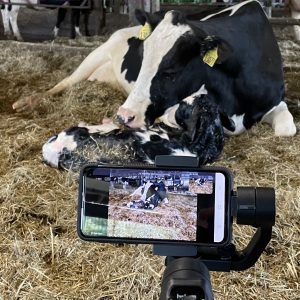About-Face: 5 Reasons Virtual Farm Trips Will Still Outperform Physical Tours Beyond the Pandemic

By Dan Toland
We’ve heard it all before, and many hold it as truth: “There’s no substitute for in-person, face-to-face interaction.”
But as COVID-19 has proven, it’s completely possible to suspend this belief when we are forced to. We are kidding ourselves if we think we will ever “get back to normal” now that we’ve HAD to think, act, work and learn differently.
But did we really need a pandemic to get to this point in our classrooms?
I’ve hosted LIVE Virtual Farm Trips for classrooms for over a decade. I was living on Zoom before others knew it existed; and I didn’t know my workstyle was considered “quarantining” until it was given a label. The pandemic certainly gave our Virtual Farm Trips® a boost, with more than a quarter million students registered for our 2021 trips alone. Now, I can look back and be certain the shift away from in-person, face-to-face interaction in the classroom was well underway before the first confirmed COVID-19 case.
The big question now in the education space is whether virtual field trips will stay hot or go by the wayside once things “get back to normal?” I have at least 5 reasons why VFTs will become even more standard in the classroom and why I’d argue they’re even BETTER than an in-person, on-farm experience.

Photo Credit: American Dairy Association North East
1. A LIVE virtual environment makes all the difference.
We focus solely on LIVE virtual experiences. It IS face-to-face communication. We’ve hosted everything from a small-scale trip where a few classrooms can be seen by the farmer and we’ve hosted extremely large-scale VFTs where tens of thousands of students are connected at once without their cameras and are just as engaged.
Regardless, the key is hosting a LIVE experience that makes the audience an integral part of the program itself. Audience buy-in is huge once it is realized that YOU are part of the program, and that it’s not nearly as good without your participation.
2. Efficiencies outweigh the alternatives.
We’ve had upward of 40,000 students connect for one trip. Try coordinating and physically running that many students through a farm in one day and let me know how that works, and what it costs. Reduced budgets and time spent aligning buses, chaperones, permissions slips, liability, biosecurity, etc. allows for much smoother operation and productivity on all sides of the equation.
Plus students stay at school for an entire day of learning, and farmers can get right back to work without interruption to their daily routine. Students see the bigger picture of the farm as well as the tiny details they might not have access to during an in-person tour. Supplementary content, multiple camera angles and multiple experts/guests can provide an expanded perspective and better understanding in a well-rounded overall experience.
3. The stats don’t lie.
Teachers love it, and they come back each year with new students for more. We’ve hosted over half a million students on VFTs throughout the years, and the registrations aren’t slowing down anytime soon.
Per our evaluations, teachers highly appreciate a live, engaging virtual tour and conversation with a real farmer in their actual work environment that is easy to connect to, well-organized and produced in a manner that makes their students part of the action.
On average, 9 out of 10 teachers say they would participate in another one of our partners’ Virtual Farm Trips, and that they’d recommend them to their colleagues. They also rate their overall VFT experience higher than an 8 out of 10.
All of this leads to a winning situation where teachers increasingly view VFTs as a highly-trusted annual source of credible agricultural information, which is exactly what our partners want.
4. Increased abilities and access
Back in the day, I spent countless hours connecting individually with teachers to prepare them for their trips and help them learn how to connect and operate the platforms we used. Thanks to the virus, educators have become Zoom-savvy, rapidly increasing VFT adoption and production efficiency.
Perhaps most importantly, the live virtual tour experience places students in a MUCH BETTER position to experience a tour than they ever could in person. EVERY student, whether joining from remote areas of Alaska or the boroughs of New York City, gets to be the one “at the front of the line” during a tour. They ALL get to see the calf up close; to ride in the combine with the farmer; to hear the farmer speak loudly and clearly while having their questions answered instead of being stuck at the back of the line and disengaged.
5. VFTs provide a great return on investment for all
While many charge for access to their virtual field trips, our Virtual Farm Trips are funded by our partners and provided absolutely FREE to classrooms. Schools also save money and resources by not having to prepare and bus students away from school for an entire day for an in-person tour.
There is also a great deal of affordability for our trip-hosting partners. In fact, one of our partners in 2021 provided a live Virtual Farm Trip experience to more than 50,000 students at the cost of just 64 cents per student! That’s a fantastic use of promotion and education resources that you’d be hard pressed to replicate.
Coronavirus or not, there’s little debate to be had at this point. It’s been time to do an about-face when considering what counts as a high-quality and super-effective face-to-face educational experience for today’s classrooms. Virtual field trips and experiences are here to stay. There’s no masking that.
Learn more about Shift•ology Communication’s Virtual Farm Trips program at VirtualFarmTrips.com.
